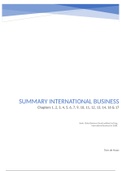SUMMARY INTERNATIONAL BUSINESS
Chapters 1, 2, 3, 4, 5, 6, 7, 9, 10, 11, 12, 13, 14, 16 & 17
Book: Global Business (fourth edition) by Peng
International Business for E&BE
Tom de Haan
, Samenvatting IB Ch. 1:
“Globalizing Business”
1.1 What Is Global Business?
International Business: a business (firm) that engages in international
economic activities, and the action of doing business abroad.
The most frequently used foreign entrant is multinational enterprise (MNE), a
firm that engages in foreign direct investment (FDI).
Global Business: business around the globe.
Instead of ‘developing country’, the term ‘emerging economy’ is used.
1.2 Why Study Global Business?
n.v.t.
1.3 A Unified Framework
“What determines the success and failure of firms around the globe?”
Institutional-based view: success and failures of firms are enabled and
constrained by institutions, the rules of the game, which deals with
external environment.
o Formal institutions: laws, regulations and rules.
o Informal institutions: values, cultures and ethics.
Resourced-based view: success and failures of firms are enabled and
constrained by a firm’s internal resources and capabilities.
Doing business abroad is challenging. Foreign firms have to overcome a
liability of foreignness, which is an inherent disadvantage that foreign
firms experience in host countries because of their non-native status.
1.4 What Is Globalization?
Globalization is the close integration of countries and peoples of the world.
Three views on globalization:
A new force sweeping through the world in recent times: new phenomenon
beginning in the late 20th century, driven by technological innovations.
A long-run historical evolution since the dawn of human history: for example,
the Roman Empire.
A pendulum that swings form one extreme to another from time to time: this
explains the ups and downs in globalization.
The two sides of globalization:
Localisation or total isolation: treating each country as a unique market.
Total globalization: treating the entire world as one market.
Between total isolation and total globalization, we find semi-globalization.
,1.5 Global Business and Globalization at a
Crossroads
The global economy in 2013 was an approximately US$75 trillion.
Firstly, it is important to understand the basics of global economy. Secondly, it is
important to critically examine your own personal views and biases.
, Samenvatting IB Ch. 2:
“Understanding Formal
Institutions: Politics, Laws
and Economics”
2.1 Understanding Institutions
Douglass North defines institutions as: “the humanly devised constraints that
structure human interaction.”
Institutional framework:
Made up of formal and informal institutions.
Supported by three pillars: regulatory (formal), normative and cognitive
(informal).
Degree of formality Examples Supportive pillars
Formal institutions Laws Regulatory (coercive)
Regulations
Rules
Informal institutions Norms Normative
Cultures Cognitive
Ethics
Regulatory pillar: the coercive/intimidating power of governments
Normative pillar: how the values, beliefs and actions of other relevant players
influence the behaviour of focal individuals and firms. For example,
Western firms imitating each other by investing in China and India.
Cognitive pillar: internal (taken-for-granted) values and beliefs that guide
behaviour.
2.2 What Do Institutions Do?
The key role of institutions is to reduce uncertainty.
Uncertainty surrounding economic transactions can lead to transaction costs (which
are costs of doing business). One important source of transaction costs is
opportunism, the act of seeking self-interest (misleading, cheating and confusing
other parties). Concluded, the key role of institutions is to reduce uncertainty, and
thus reducing transaction costs.







